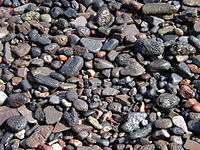
Photo from wikipedia
BACKGROUND Musculoskeletal disorders (MSDs) and associated musculoskeletal symptoms (MSS) are problematic in stone, sand, and gravel mining. Research is needed to explore relationships between job demands, work-related hazards and MSS.… Click to show full abstract
BACKGROUND Musculoskeletal disorders (MSDs) and associated musculoskeletal symptoms (MSS) are problematic in stone, sand, and gravel mining. Research is needed to explore relationships between job demands, work-related hazards and MSS. OBJECTIVE An exploratory study was conducted in Indiana during 2019-2020 to examine associations between job demands, work-related hazards and MSS. METHODS Through convenience sampling, cross-sectional survey data from 459 workers were collected and analyzed using logistic multiple and binary logistic regression methods. Outcome variables were MSS to the low back, neck/shoulder, and wrist/hand. Predictor variables and MSS measures are based on the Dutch Musculoskeletal Questionnaire. RESULTS Increased odds of low back MSS were related to dynamic loads (OR = 2.14), pushing/pulling heavy loads (OR = 1.56), torso bending or twisting (OR = 2.36), bent, stooped, or twisted posture (OR = 2.04), uncomfortable postures (OR = 2.07), repetition (OR = 1.67) and vibrating tools (OR = 1.81). Increased odds of neck/shoulder MSS were related to dynamic loads (OR = 1.83), static loads (OR = 1.24), heavy lifting (OR = 1.50), pushing/pulling heavy loads (OR = 1.68), bending or twisting of the neck (OR = 1.82), twisted neck posture (OR = 1.77) and uncomfortable postures (OR = 1.81). Increased odds of wrist/hand MSS were related to dynamic loads (OR = 2.06), static loads (OR = 1.45), bending or twisting of the wrists/hands (OR = 10.52), extended reaching (OR = 3.05), repetition (OR = 5.25), awkward postures (OR = 4.47), working above shoulder level (OR = 2.47), and vibrating tools (OR = 1.78). CONCLUSION Hazards that increased the likelihood of MSS were identified. These hazards should be abated or controlled to prevent MSDs in stone, sand, and gravel mining. More applied research, including ergonomic assessments to further identify hazards that can be controlled or abated, is warranted.
Journal Title: Work
Year Published: 2023
Link to full text (if available)
Share on Social Media: Sign Up to like & get
recommendations!